(Sample Material) Online Coaching for CAPF (AC): Geography - "World Geography (Part - 5)"
Online Coaching for UPSC Central Armed Police Forces (AC) Written Examination
Geography
World Geography (Part - 5)
World Agriculture
Rice
- The earliest date of rice cultivation is supposed 7000 years ago in the Chang-Jiang delta of China.
- The rice plant (paddy) requires high temperature (27°-30°C) and high rainfall (about 100 cm) during its growth period.
- Clayey, loam soil is best suited for its cultivation.
- It is a labour intensive crop.
- Ninety per cent of the world’s rice is grown in East and South Asia.
- It is the principle food crop for half the population of the world.
- Paddy is categorized into two group-Wet paddy and Dry paddy.
- Its different and new varieties are IR8, IR20, IR22, Miracle Rice, etc.
- ‘Miracle Rice’ is developed in Philippines at the Rice Research Institute of Manila.
- ‘Floating rice’ can be grown in water upto 5m deep.
- Diseases such as Stomatitis, Glossitis and Cheilosis are common in the Orient because of polished rice.
Top Six Rice Producers
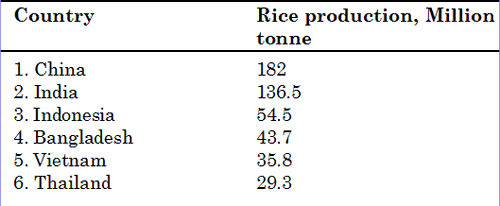
Top Six Rice Yield
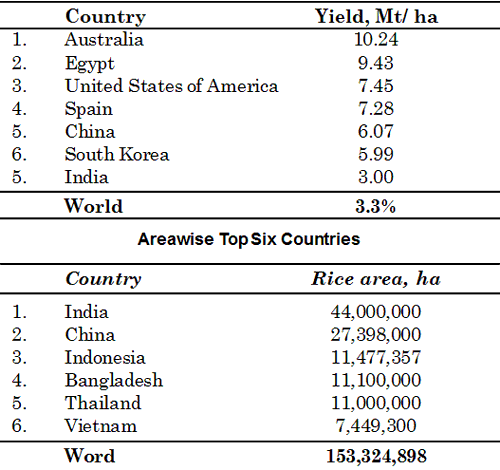
Beri-Beri is also caused by polished rice wherein Vitamin A and B are removed due to polishing.
Productions & Yields
- Rice yields vary from 1000kg/hectare in Laos to 6100 kg/hectare in Japan and South Korea.
- China is the largest producer (28.8%) in the world. Approximately a third of China’s farmland is under rice.
- China has about 44 million hectares of land under rice. Red basin is the most important rice producing area of it and is called the Ricebowl of China.
- The northern limit of rice cultivation in China is demarcated by Quinlingshan mountain ranges and the river Hwang Ho.
- India is the second largest rice producer (21.6%) in the world. A quarter of India’s cultivated land is under rice.
- India has the largest area under rice in the world followed by China, Indonesia and Bangladesh.
- Indonesia is the third largest producer (8.6°%) in the world. It is raised as either Sawah (Wet paddy) or huma (dry paddy).
- Japan has one of the highest yielding in the world. ‘Japonica’ is the high yielding paddy hybrids developed by it.
- Japan is the second largest producer of rice in East Asia. The Setouchi plain of Honshu is the rice bowl of Japan.
- The international trade in rice is very small, involving only 3 to 5% of the total production.
- Thailand and Myanmar are the traditional leaders in rice exports in the world.
- In Malayasia, paddy occupies the second greatest cultivated acreage after rubber and nearly 95% of the paddy grown is wet paddy. High yielding variety like ‘Bahagia’ is used very much.
- Brazil producing only 1.8% of the world’s total production is the greatest rice-growing nation in the southern continent of America.
- USA produces about l% of the world’s rice. The leading rice state is Louisiana, followed by California, Texas and South Carolina.
- The largest production of rice is in the China followed by India, Indonesia and Bangladesh.
- Rice yield is highest in Australia followed by Egypt, USA and Spain.
- East Asia covers nearly 25% of total world area under rice which contributes nearly 40% of total world production of rice.
Wheat
- Wheat is an annual grass crop which belongs to the Gramineae and the genus Triticum.
- According to growing seasons, it is divided into two groups - winter wheat and spring wheat.
- Winter wheat is sown in late autumn or early winter and harvested in early summer.
- Winter wheat is usually grown in regions of the middle latitudes.
- Spring winter is grown in the colder north of Oats Alberta the Canadian Prairies and in parts of the continental steppes and Siberia.
- Spring wheat is sown in spring and harvested in late summer or autumn.
- Both winter and spring wheat may be either hard or soft. The hard wheat has low moisture content and is best suited for bread-making. The soft wheat, with higher moisture content, is more suited for making cakes, biscuits and pastries.
- Over-irrigation should be avoided as high humidity may cause a disease known as ‘Redrot’.
Temperature, Rainfall and Soil
- It is mainly a crop of the temperate region.
- The annual rainfall is required between 40 to 75cm. An average temperature of 16°C and clear sky are required at the time of ripening.
- Loam and Chernozem soils are best suited for wheat cultivation.
Production and yield
- There are over 204 million hectares of land under wheat cultivation and over 549 million tonnes wheat are produced in the world annually.
Wheat Producers (2008-09)
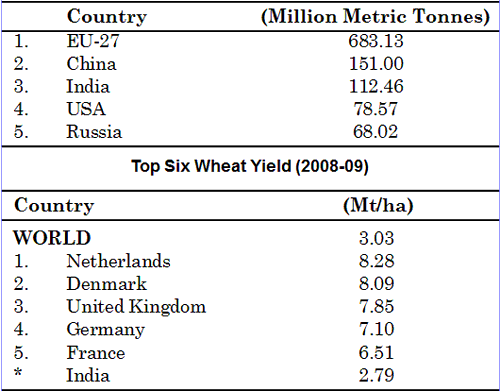
Area wise Countries (2008-09)
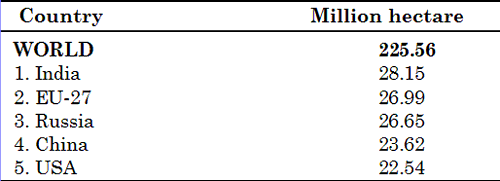
- In USA, Nebraska separates the winter wheat belt from spring wheat belt. The largest milling centre of spring wheat belt is in Minneapolis while Kansas City, Topeca, Wichita and Oklahoma city are important milling centres of winter wheat belt.
- Almost all the wheat from Canada is spring wheat and 95% of the total comes from the prairie provinces of Saskatchewan, Alberta and Manitoba.
- The wheat Crescent of the Pampas (in Argentina) from Rosario to Bahia Blanca is famous for wheat production.
- Black earth of USSR, Paris Basin, the Lombardy plain of Italy, the Lower Danube Basin are famous for wheat production.
- France is the largest producer and the only exporter of wheat among European countries excluding European parts of Russia.
- 37‘’ parallel is northern limit of wheat growing in Japan.
- USA, Canada, Argentina and Australia are the main exporters of wheat.
- International Research Institute have been established at Damascus and Mexico
- Brazil is the largest importer of wheat in South America.
Maize
- Maize is known as Makka in India, corn in the USA and Indian corn in Europe.
- It is originated from American continent.
- It was introduced into Europe by Christopher Columbus.
- It is the third after wheat and rice in terms of area cultivated.
- Types of Maize:
(i) Dent corn
(ii) Flour corn
(iii) Flint corn
(iv) Waxy corn
(v) Sweet corn
(vi) Pod corn
(vii) Pop corn
Temperature, Rainfall and Soil
- Maize usually requires summer temperatures of between 18° and 27°C during the day and around 14°C during the night. The most essential climatic factor is a period of 140 frost-free days.
- Rainfall varies from 30 to 100 cm annually.
- It grows in a wide range of soil types from the temperate podzols to the strangely leached red soils of the tropics. However it grows best in deep nitrogen rich soils of the sub-tropics.
Production and yield
Area wise Top Six Countries
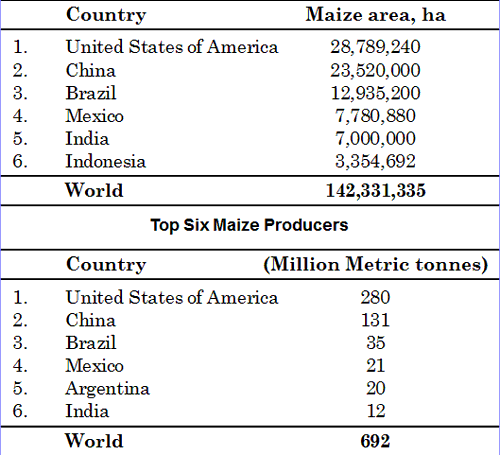
- USA is the largest producer and seller of maize in the international market followed by China, Brazil, Mexico and Argentina.
- Area-wise also, USA is the leading country followed by China, Brazil, Mexico and India.
- About half of the world’s maize is grown in USA, but 80% of it is used for animal feed and corn oil.
- USA is the largest exporter of corn in the world.
- Argentina is also major exporter of corn in the world.
Tea
- ‘Tea’ is made from the leaves of a tropical shrub of the `Camellia’ family.
- Tea cultivation is believed to have originated in the Chang Jiang Valley of China.
- There are two major varieties of tea – small leaved China tea, i.e. green tea (Sencha) and large-leaved Assam tea i.e. black tea.
- A stimulating substance called tannic acid is found in the leaves.
- Major tea varieties - Black tea from India and Sri Lanka; Green tea from China; Oolong tea from Taiwan; Yerba mate from Paraguay.
Temperature, Rainfall and Soil
- It requires warm and humid climate but water should not stagnate near the roots. It grows best in the monsoon lands of the tropics and the sub-tropics.
- It is grown mainly in a region between 27° S and 43°N latitudes on hill slopes.
- It requires moderate temperature of about 25°C and a rainfall between 125 cm and 750 cm annually.
- The most suitable soils are slightly acidic and without calcium. The presence of iron in the sub-soil is desirable.
- Its plant grows well in fertile soils with high humus content. And application of nitrogen fertilizers is essential to maintain soil fertility.
Production
- India, China, Sri Lanka, Bangladesh, Japan, Indonesia, Argentina and Kenya are the main tea producing countries.
- India, with 8,20,000 tonnes in 2004, is the largest producer of tea followed by China, Kenya and Sri Lanka.
- In India, Assam, Darjeeling and Kerala are major tea producing areas.
- Kenya is the largest exporter, once again surpassing Sri Lanka and China.
Top Six Tea Producers

Tea Exporters (2004)

- European community, USA and Japan are the major importing countries.
- In China, Chang Jiang valley and Szechwan Basin are major areas of tea production.
- The main region of Taiwan is north-west hilly region around Taihoku.
- The greatest concentration is on the eastern slopes of the Japanese Alps in southern Honshu especially in Shizuoka Perfecture which accounts for half of Japan’s tea output.
- The Western Java of Indonesia is also main tea producing region of Indonesia.
- The bulk of the black tea of Bangladesh is exported through Chittagong.
- Malaysia, Malawi, Mozambique and Uganda are other tea producing countries.
Coffee
- It is a leading tropical commodity in international trade and is the chief export crop of many of the Latin American and Caribbean countries.
- The coffee tree is a native of the highlands of southern Ethopia and the name coffee is derived from that of the highland district of Kaffa where it was found.
- Its main stimulant is caffeine.
- One-third of the world population drinks coffee, the second largest beverage after tea.
- There are three types of coffee plants-coffee Arabica, Coffee Robusta and Coffee Liberica. Robusta is the main variety produced in the world.
- Other varieties are Mocha Coffee (Arabian Peninsula), Blue Mountain Coffee (in Jamaica and other West Indian Islands) and Java coffee.
- Both Robusta and Liberica are widely grown in Africa.
Temperature, Rainfall and Soil
- It grows in the tropical highlands at an altitude between 500 and 1500 metres above sea-level.
- It requires from 14°C to 26°C as mean monthly temperature. Coffee Arabica requires temperature of 15° to 20° C while Coffee Robusta requires a little higher temperature, i.e. 20° to 30°C.
- It requires high humidity conditions and rainfall between 160 and 250 cm.
- Generally, coffee grows in deep, porous and water retentive soils with high humus content. Welldrained volcanic soils like the ‘terra roxa’ of Brazil which contain much potash as well as organic material are the best.
Production
- Brazil is the largest producer followed by Columbia, Indonesia and Vietnam. India ranks fifth in the coffee production.
- Large coffee plantation in Brazil is known as ‘FAZENDA’.
- Sao Paulo is the centre of the coffee trade and its outport. Santos, the coffee port of Brazil, handles more coffee exports than any other port.
Top Six Coffee Producers
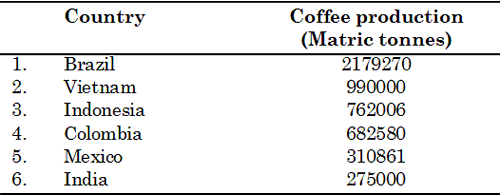
- The chief coffee centres of Columbia are Medellin, Manizales and Talima.
- Columbian coffee has an excellent flavour and fetches higher prices than Brazilian coffee. It produces about 60% of the world’s mild coffee.
- Mocha coffee is grown mainly in Yemen.
- In India, Karnataka is the largest producer of coffee.
- India contributes around 4% of the world production.
- The main coffee exporting countries are Brazil, Colombia, Indonesia and Ivory Coast.
- USA, Germany, France and Italy are main importing countries.
- Africa contributes about 20% of the coffee entering the international trade. Ethiopia, Kenya, Uganda, Angola and Ghana are important coffee producing countries of Africa.
Rubber
- Rubber is the latex of the tree ‘Have a Brasiliensis’. It is widely found in the tropical forest of Amazon and Zaire basins.
- The local people of Amazon basin called the latex as ‘Cahuchu’ (tears of the trees).
- The rubber is obtained through gathering in the Amazon basin where rubber-gatherers are called ‘Seringueos’.
- After the discovery of vulcanisation, it became more useful.
Temperature, Rainfall and Soil
- Equatorial climate is best suited for it.
- It requires high temperature of about 27° C and rainfall of 150 cm evenly distributed throughout the year.
- Deep, friable, well-drained soils are ideal and acidic soils are also suitable.
Production
- Malayasia had been the leading producer of rubber but now shifted to third position (in 2004).
- The world natural rubber production has reached to 8.34 Million Mt in 2004.
- Thailand is ranked on first position in rubber production in the world (in 2004).
- Thailand is followed by Indonesia, Malaysia and India.
- India is 4th largest producer and consumer of natural rubber.
- Cote d’Ivoire and Liberia are major rubber producing countries in Africa.
- Liberia claims to have the world’s largest single plantation.
- Synthetic rubber was first made by Germany before the First World War.
- Synthetic rubber is made of certain kinds of Hydrocarbons. Of these butadiene is the most important.
- USA is the largest synthetic rubber producer.
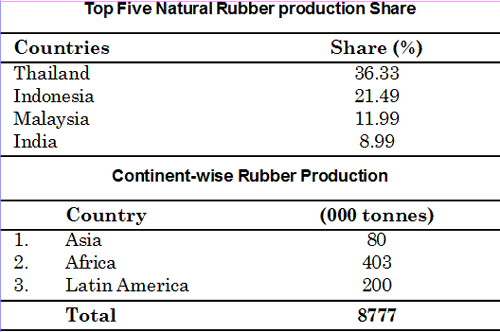
- However Thailand, now leading producer, along with Malaysia and Indonesia has the largest share in production as well as in trade in the world.
Continent-wise Synthetic Rubber Production

Jute
- Jute is the fibre obtained from certain species of the corchorus family.
- It is a coarse rather soft fibre and is thus the second most important vegetable fibre.
Temperature, Rainfall and Soil
- Jute grows well in hot, tropical condition with plenty of moisture and heavy rainfall is essential.
- It requires rich soils and thrives on river alluvium, especially where annual floods renew the fertility of the soil.
- It is suited to much the same regions as wet paddy and is often grown as a cash crop in paddy-growing areas.
Production
- Almost all the world production of jute comes from India and Bangladesh.
- Most of the jute is grown in the fertile, alluvial, annually flooded area at the mouth of the Ganges and Brahmaputra rivers.
- Manufactured jute and raw jute are also exported from India and Bangladesh.
- The largest jute producer is India followed by Bangladesh, China and Myanmar.
- Jute is increasingly produced in Wet conditions in the Amazon delta of Brazil.
Jute Production

- World production of jute is projected at 2.4 million tones by 2010. China’s emergence as an established net importer in the world market is expected to increase the proportion of jute traded, from 36% to 39% in 2010.
- Bangladesh is expected to remain the largest net exporting country accounting for over 75% of world trade in aggregated jute fibre and goods.
- India, being the second largest exporter, is expected to remain stable at approximately 185000 tonnes.
Cotton
- Cotton comes from cultivated plant from the genus Gossypium.
- Cotton is an ancient crop in India and Egypt.
- After the discovery of the cotton gining machine in 1793, there was a revolutionary change in the production and utilization of cotton.
- Cotton varieties are usually distinguished by the staple length. The longer the staple, the finer are the fibres.
- There are three types of cotton: long staple, medium staple and short staple.
- Long staple cotton: The longest staple cotton is the ‘sea island cotton’, which is now largely grown in the West Indies. The main producing regions are south coast of USA, Puerto Rico and other islands of West Indies. Egypt is one of the major producers of long staple cotton and has developed many varieties of it.
- Medium staple cotton: It is produced in Nile basin, Soviet Central Asia and USA. It is also known as Egyptian cotton. American upland cotton is an example of this size.
- Short staple cotton: It is the shortest and the coarsest of the cotton. It is produced mainly in Asian countries and Brazil.
Temperature, Rainfall and Soil
- Cotton is essentially a plant of dry climate. Cotton requires warm climate but temperature between 21° and 27° C is ideal during the period of its growth.
- Cotton plant can tolerate as high temperature as 40°C but it should not be lower than 21°C.
- It cannot tolerate frost. So, it needs 210 frost free days.
- Moderate to light rainfall is adequate for its production. A rainfall of 50 cm is enough but it should be evenly distributed.
- In the USA, cotton belt is limited in south by the rainfall of 255 mm in the late summer and autumn.
- Medium loams with good drainage are ideal. Volcanic, black and alluvial soils are most suitable for it.
- It requires intensive fertilizer use.
Distribution and Production
- USA remained a major cotton producer for a long time.
- Cotton belt of USA is located in its southern part. The northern limit of this belt is determined by 210 frost free days and 25°C summer isotherm.
- In China, it is produced in north China plain, Wel Ho Valley and lower Chang Jiang Valley.
- The major cotton producing regions of Central Asia lies in Tajikistan, Kazakhstan, Turkmenistan and Uzbekistan.
- In India, cotton is produced in the black soil region.
- Sao Paulo in Brazil, Nile Delta in Egypt, Indus Valley of Pakistan and Jazira of Sudan are cotton producing regions.
- Area-wise, India has the largest area under cotton cropping followed by China, USA and Pakistan.
- Australia has the highest yield per hectare followed by Syria, Mexico and Turkey.
Country-wise Cotton Area (2004-05)
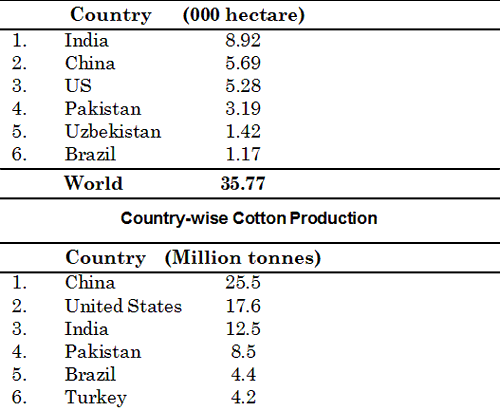
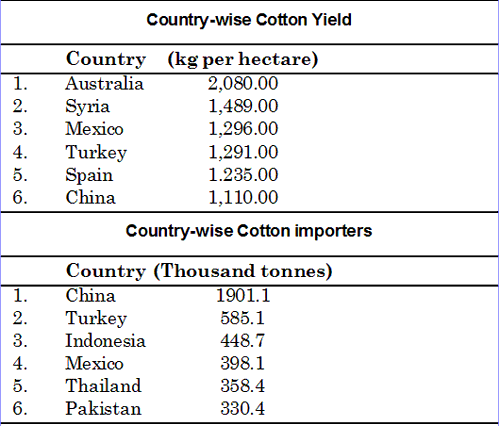
- China is the leading cotton producing country in the world followed by USA, India, Pakistan and Brazil.
- Common pest in cotton crop is the ‘boll-weevil’ in North America and `pink bollworm’ in Asia.
- The main cotton-growing areas of USA has been shifting to the West because of the bollWeevil which is sensitive to both frost and drought.
